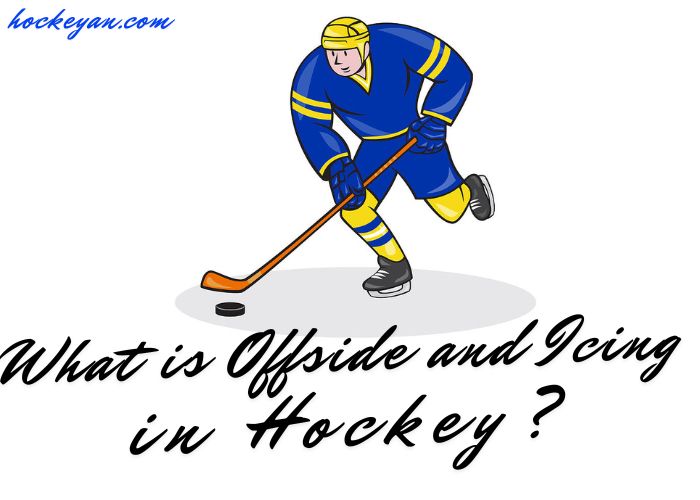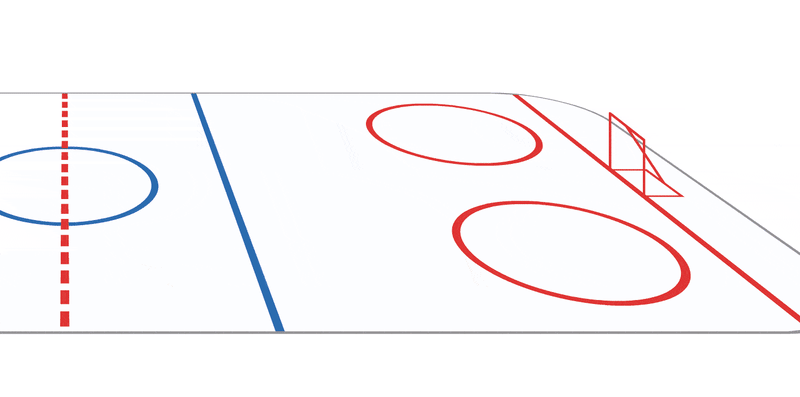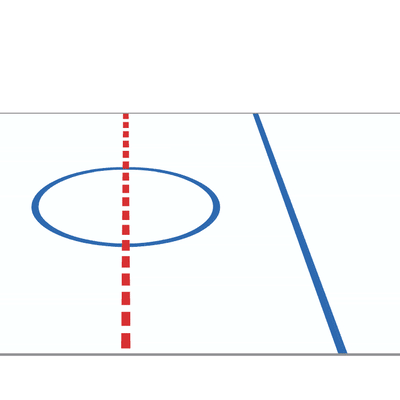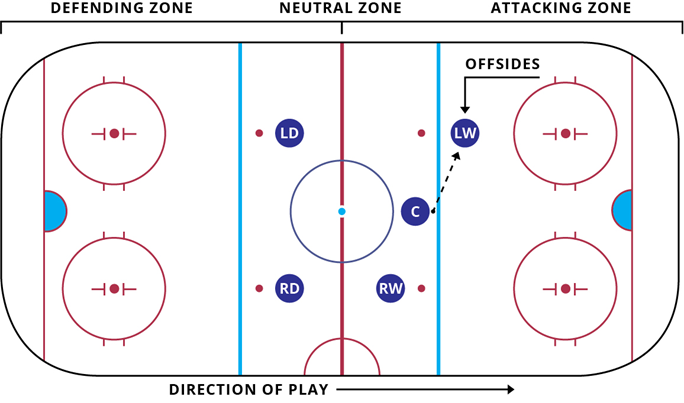What is Offside and Icing in Hockey? Offside in hockey occurs when a player enters the attacking zone before the puck. Icing happens when a player shoots the puck across both the centre red line and the opposing goal line without touching it.
Understanding hockey rules like offside and icing is crucial for both players and fans. Offside helps maintain fair play by ensuring players do not gain an unfair advantage. Icing, on the other hand, prevents teams from simply dumping the puck to relieve pressure.
These rules keep the game fast-paced and exciting. Knowing these basics enhances appreciation of the game, making it more enjoyable to watch. So, whether you’re a newcomer or a seasoned fan, grasping these concepts is essential for fully enjoying hockey.
Credit: www.reviewjournal.com
The Basics Of Offside In Hockey
Understanding offside in hockey is crucial for both new and experienced fans. This rule ensures fair play and maintains the game’s flow. Let’s dive into the essentials of the offside rule in hockey.
Defining The Offside Rule
The offside rule in hockey is simple but vital. A player is offside if they enter the attacking zone before the puck. This means the player’s skates cross the blue line before the puck does, and the puck must always cross the blue line first.
To avoid being offside, players must time their entry into the attacking zone. This ensures the game is fair and prevents cherry-picking. Cherry-picking is waiting near the opponent’s goal without playing defence.
The Role Of The Blue Line
The blue line is critical in the offside rule. It marks the boundary of the attacking zone. The attacking zone is the area between the opponent’s goal line and the blue line.
There are two blue lines on a hockey rink. They divide the rink into three zones: defensive, neutral, and attacking. Understanding these zones helps in grasping the offside rule better.
| Zone | Description |
|---|---|
| Defensive Zone | The area from your goal line to the nearest blue line |
| Neutral Zone | The area between the two blue lines |
| Attacking Zone | The area from the opponent’s blue line to their goal line |
To avoid offside, players must always be aware of their position relative to the blue line. They must ensure the puck crosses into the attacking zone first.
- Watch the blue line.
- Time your entry into the zone.
- Ensure the puck crosses first.
Following these basics helps players stay onside. This keeps the game fast and fair.
Credit: www.reviewjournal.com
Breaking Down The Offside Play
Understanding the offside rule in hockey can take time and effort. It’s essential for both players and fans. Let’s break it down step by step.
Player Positions And Offside
Offside occurs in the offensive zone, which is past the blue line. Players must follow specific positions.
- The puck must cross the blue line before any attacking players.
- If a player crosses first, it’s offside.
- Defensive players and the goalie must be aware of their positions.
Here’s a quick table to understand player positions:
| Player | Position |
|---|---|
| Forward | Near the opponent’s goal |
| Defenseman | Near their own goal |
| Goalie | Protecting their goal |
Common Offside Scenarios
There are several offside scenarios. Here are the most common:
- Early Entry: A player crosses the blue line before the puck.
- Delayed Offside: An offside player waits to re-enter the zone.
- Pass Interference: A player receives the puck in an offside position.
Understanding these scenarios helps players avoid mistakes. It also allows fans to enjoy the game more.
Consequences Of Offside Violations
Understanding the consequences of offside violations in hockey is crucial. It helps players and fans grasp the game’s flow and strategies. When a player crosses into the opponent’s zone before the puck, it’s offside. This leads to a stoppage in play and specific consequences.
Faceoff Procedures Following Offside
After an offside violation, the game restarts with a faceoff. The faceoff occurs at one of the nine designated faceoff spots. The spot depends on where the offside occurred. Usually, the faceoff happens just outside the offending team’s blue line. This gives the other team a strategic advantage. Below is a simple table explaining the faceoff spots:
| Offside Location | Faceoff Spot |
|---|---|
| Near Blue Line | Just Outside Blue Line |
| Center Ice | Center Ice |
| Far Blue Line | Just Outside Far Blue Line |
Impact On Game Flow And Strategy
Offside violations disrupt the game flow. They cause stoppages, breaking the momentum of the attacking team. Coaches adjust their strategies based on these stoppages. For example, a team might change lines to bring fresh players. These interruptions can also change the game’s tempo.
Teams must be cautious to avoid repeated offsides. Frequent violations can lead to penalties and loss of control. Players must work together to stay onside and maintain possession. This requires good communication and awareness on the ice.
Offside violations also affect defensive strategies. Defenders use the blue line to trap offensive players, forcing the opposing team to regroup and try again. Understanding offside rules and consequences is key for both offence and defence.
Credit: www.hockeymonkey.com
Icing: The Basics
Hockey is an exciting and fast-paced game. Understanding the rules helps you enjoy it. One such rule is icing. Let’s break down icing for you.
Icing Rule Simplified
Icing happens when a player shoots the puck across both the centre red line and the opposing team’s goal line without touching another player. The puck must cross these lines without a player touching it.
If this happens, the referee stops play. The face-off then occurs in the defensive zone of the team that committed icing.
Purpose Behind The Icing Rule
The icing rule exists to keep the game fair and balanced. It prevents teams from merely shooting the puck down the ice to waste time and encourages more skilful play and strategy.
Here is a simple table to understand icing:
| Action | Result |
|---|---|
| The puck shot across the centre and goal line | Possible icing |
| The puck touches another player | No icing |
| Referee stops play | Face-off in the defensive zone |
Here are some key points:
- Icing helps keep the game moving.
- Teams must use skill, not just shoot the puck aimlessly.
- Referees make sure the rule is followed.
Identifying Icing In Action
Understanding icing in hockey can be tricky for new fans. It’s a rule that helps keep the game fair and exciting. This section will help you identify icing during a match.
When Does Icing Occur
Icing occurs when a player shoots the puck from their half. The puck must cross the opposing team’s goal line. No player from the shooting team can touch it before an opponent, causing a stoppage in play.
Here are the key points to look for:
- Origin of the shot: The puck is shot from behind the centre red line.
- Path of the puck: The puck crosses the opponent’s goal line without being touched.
- No player touches: No player from the shooting team touches the puck first.
Exceptions To The Icing Rule
There are several situations where icing does not apply:
- Power play: The short-handed team can ice the puck without penalty.
- Goalkeeper play: If the goalie leaves the crease and touches the puck, icing is waived off.
- Referee’s judgment: Sometimes, referees can decide to wave off icing for safety reasons.
| Scenario | Icing Applies? |
|---|---|
| Shot from behind the centre line | Yes |
| Shot during a power play | No |
| The goalie touches the puck | No |
Penalties And Icing Calls
Icing and offside are crucial rules in hockey. They keep the game fair and fast-paced. Icing occurs when a player shoots the puck from behind the centre red line across the opponent’s goal line. Offside happens when a player enters the attacking zone before the puck. These rules result in stoppages and face-offs, impacting team strategies and game flow.
Referee’s Role In Icing Situations
Referees play a vital role in making icing calls. They watch the puck’s trajectory and determine if it crosses the goal line without being touched. If icing is called, the play stops, and a face-off occurs in the offending team’s zone. Referees ensure fair play and maintain the game’s pace.
How Icing Affects Team Strategies
Icing significantly impacts team strategies. Teams must be cautious with long passes and clearing attempts. Icing can lead to face-offs in their defensive zone, putting them at a disadvantage.
Coaches often adjust their line changes to avoid icing calls. They might instruct players to dump the puck strategically. This helps maintain control and avoid unnecessary stoppages.
| Team Action | Impact on Game |
|---|---|
| Dump and Chase | Reduces icing risk, maintains puck control |
| Long Passes | Increases icing risk, potential face-off in defensive zone |
Teams with strong defensive capabilities might use icing to relieve pressure. They can handle defensive zone face-offs more effectively. On the other hand, offensive teams focus on maintaining puck control to create scoring opportunities.
Comparing Offside And Icing
Hockey has several rules that keep the game fair. Two such rules are offside and icing. Both are crucial for the sport. But they serve different purposes.
Differences In Rules And Objectives
The offside rule ensures fair play. A player cannot enter the attacking zone before the puck. This prevents cherry-picking. The objective is to maintain a balanced game.
Icing, on the other hand, stops long passes. When a player shoots the puck across both the centre red line and the opponent’s goal line, it is icing. The puck must also be untouched. The objective of icing is to stop teams from wasting time.
| Aspect | Offside | Icing |
|---|---|---|
| Rule | The player enters the attacking zone before the puck | The puck crosses two lines untouched |
| Objective | Ensure fair play | Prevent time-wasting |
How Both Rules Shape Hockey Dynamics
The offside rule keeps players honest. They need to time their moves carefully. This leads to strategic plays and teamwork.
Icing affects the pace of the game. It forces teams to make shorter, more accurate passes. This rule creates more face-offs, adding excitement and unpredictability.
Both rules ensure hockey remains a fast, thrilling sport. They balance offence and defence, making the game fair and fun to watch.
Evolution Of Offside And Icing Rules
The rules of offside and icing in hockey have evolved. These changes have shaped the game into what it is today. Understanding these changes helps us appreciate the sport better.
Historical Changes And Their Impact
Offside and icing rules have seen many modifications since their inception. Initially, the rules were straightforward. Over time, they became more complex to keep the game fair and exciting.
| Year | Rule Change | Impact |
|---|---|---|
| 1929 | Offside introduced | Reduced goal-scoring; added strategy |
| 1937 | Icing rule implemented | Prevented time-wasting; increased continuous play |
| 1996 | No-touch icing | Improved player safety |
The offside rule prevents players from positioning themselves near the opponent’s goal before the puck enters. This rule keeps the game balanced and fair. The icing rule stops teams from simply shooting the puck down the ice to waste time. It encourages continuous play and keeps the game dynamic.
Future Considerations For Rule Adjustments
As the game evolves, so do the rules. Future changes may focus on improving player safety and enhancing game flow. Technology might also play a role in these changes. Video reviews could become more common for offside and icing decisions.
- Improved player safety
- Enhanced game flow
- More technology use
Rule adjustments could include refining the offside rule to reduce stoppages. Another idea is to tweak the icing rule to encourage more offensive plays. These changes would make the game faster and more enjoyable for fans.
Frequently Asked Questions
What Is Icing And Offside In Hockey?
Icing occurs when a player shoots the puck across both the centre red line and the opposing goal line. Offside happens when an attacking player enters the offensive zone before the puck.
What Is An Offside In Hockey?
Offside in hockey occurs when a player crosses the opponent’s blue line before the puck. This results in a stoppage of play. It helps maintain fair gameplay by preventing premature offensive advantages.
What Is The Point Of Icing In Hockey?
Icing in hockey stops play when a player shoots the puck across both the centre line and the opposing goal line without touching it. This rule prevents teams from simply dumping the puck to waste time.
How Long Can A Hockey Player Stay On The Ice?
A hockey player typically stays on the ice for 45 seconds to 1 minute per shift. Shifts can vary based on game intensity.
Conclusion
Understanding offside and icing is crucial for hockey fans. These rules keep the game fair and exciting. Now that you know the basics, you can enjoy watching and playing hockey even more. Keep these key points in mind, and you’ll appreciate the sport’s complexity and strategy.
Happy hockey-watching!







